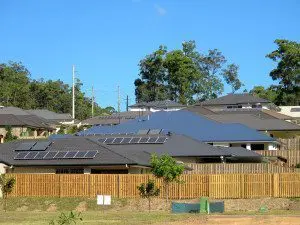The Australian Energy Market Commission, the main rule maker for the industry, is canvassing a potential “solar tax” that could be charged by networks on solar households exporting surplus capacity back into the grid.
The proposal is included in the AEMC’s draft report on the Distribution Market Model, in which it argues that a solar tax may be needed because there is no other way for networks to recoup their costs from solar households.
The proposal is sure to court great controversy in the solar industry. Solar households are already paid little more than the wholesale rate of electricity, partly on the basis that network charges “are unavoidable” for retailers. They suggest that if small generators are charged for network use, then maybe the large generators should be too.
Even though it is recognised that solar has reduced demand peaks, and wholesale prices, and pushed absolute peaks from the late afternoon to early evening, the network benefits are not recognised in any solar tariff. But now the networks are pushing for added charges.
Solar taxes have been considered before. The SA Power Networks proposed a $100 supplementary charge to solar households, but was rejected. Spain and Denmark have both imposed solar taxes, but these appear designed more as general revenue measures.
The AEMC is concerned that rooftop solar is getting a free ride because it does not pay for the use of the grid when solar power is exported, and because solar households tend to use less electricity from the grid because of their rooftop solar panels.
Currently, clause 6.1.4 of the NER prohibits a DNSP from charging a distribution network user (such as an owner of a distributed energy resource) distribution use of system charges for the export of electricity by that user to the distribution network.
There may be cause to revisit this clause if DNSPs incur costs (and benefits) due to the export of energy from distributed energy resources (or passive solar PV systems) that are not appropriately reflected in connection charges and where these costs (and benefits) increase (albeit not necessarily proportionately) with the volume of injections.
The Commission therefore considers that there may be benefits in exploring the deletion of clause 6.1.4 of the NER, and what possible alternatives there are.
Mark Byrne, from the Total Environment Centre and an expert on network regulation, says it appears that the rule is designed to affect households with rooftop solar and battery storage, and larger distributed energy resources.
He says the push for a solar tax is being made by some networks and consumer representatives on the basis that “solar is getting a free ride on the backs of non-solar consumers.”
This argument is based on the idea that the impact of high bidirectional flows, as consumers import and export to and from the grid, and the lower overall consumption of solar households means network revenues have to be recovered through high volumetric or fixed charges.
But Byrne argues that there is little evidence that solar imposes significant engineering costs to networks under at least a 40 per cent penetration, and that these additional costs (where proven) can largely be recovered through connection charges.
“The relatively small cross-subsidy caused by lower total consumption by solar owners can be eliminated by moving to more cost reflective network and retail tariffs (recovering more from peak charges and less from volumetric),” he says.









